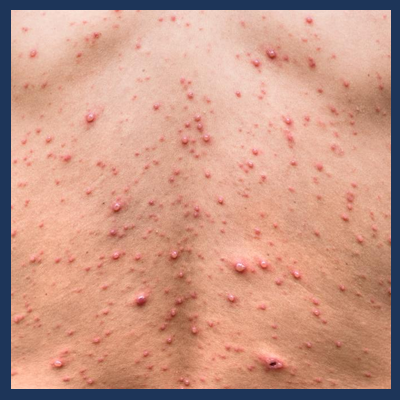

Patient, usually a child, develops an eruption of successive crops of limpid vesicles, usually accompanying a slight elevation of fever. It is mostly a trivial disorder of childhood. It is accompanied by malaise, headache and backache, and sometimes a prodromal scarlatiniform, morbilliform or urticarial rash. Within twenty four hours, a characteristic rash appears. It is a case of CHICKENPOX or VARICELLA.
The characteristic eruption is dark pink, slightly raised, ovoid or some what pyramidal papules, which in the course of a few hours become vesicular. The typical vesicles is at first a thin walled, translucent, unilocular, glistening bleb which contains a clear fluid in the most superficial layer of the skin . within two weeks these scabs fall off leaving behind a pigmented scab. Pleomorphism is the character of this infection. The temperature rarely exceeds beyond 103 f. These scabs are very infection and need to be disposed of by burning them.
The itchy blister rash caused by chickenpox infection appears 10 to 21 days after exposure to the virus and usually lasts about five to 10 days. Other signs and symptoms, which may appear one to two days before the rash, include:
Once the chickenpox rash appears, it goes through three phases:
New bumps continue to appear for several days, so you may have all three stages of the rash — bumps, blisters and scabbed lesions — at the same time.
The disease is generally mild in healthy children. In severe cases, the rash can cover the entire body, and lesions may form in the throat, eyes, and mucous membranes of the urethra, anus and vagina.
Chickenpox infection is caused by a virus. It can spread through direct contact with the rash. It can also spread when a person with the chickenpox coughs or sneezes and you inhale the air droplets.
Chickenpox is normally a mild disease. But it can be serious and can lead to complications including:
People who are at higher risk of chickenpox complications include:
Low birth weight and limb abnormalities are more common among babies born to women who are infected with chickenpox early in their pregnancy. When a mother is infected with chickenpox in the week before birth or within a couple of days after giving birth, her baby has a higher risk of developing a serious, life-threatening infection.
If we had chickenpox, we're at risk of a complication called shingles. The varicella-zoster virus remains in your nerve cells after the skin infection has healed. Many years later, the virus can reactivate and resurface as shingles — a painful cluster of short-lived blisters. The virus is more likely to reappear in older adults and people who have weakened immune systems.
The pain of shingles can persist long after the blisters disappear. This is called postherpetic neuralgia and can be severe.
Two shingles vaccines (Zostavax and Shingrix) are available for adults who have had chickenpox. Shingrix is approved and recommended for people age 50 and older, including those who've previously received Zostavax. Zostavax isn't recommended until age 60. Shingrix is preferred over Zostavax.
The chickenpox (varicella) vaccine is the best way to prevent chickenpox. Experts from the Centers for Disease Control and Prevention (CDC) estimate that the vaccine provides complete protection from the virus for nearly 98 percent of people who receive both of the recommended doses. When the vaccine doesn't provide complete protection, it significantly lessens the severity of chickenpox.
The chickenpox vaccine (Varivax) is recommended for:
Young children. In the United States, children receive two doses of the varicella vaccine — the first between ages 12 and 15 months and the second between ages 4 and 6 years — as part of the routine childhood vaccination schedule.
The vaccine can be combined with the measles, mumps and rubella vaccine, but for some children between the ages of 12 and 23 months, the combination may increase the risk of fever and seizure from the vaccine. Discuss the pros and cons of combining the vaccines with your child's doctor.
Unvaccinated adults who've never had chickenpox and are at high risk of exposure. This includes health care workers, teachers, child care employees, international travelers, military personnel, adults who live with young children and all women of childbearing age.
Adults who've never had chickenpox or been vaccinated usually receive two doses of the vaccine, four to eight weeks apart. If you don't remember whether you've had chickenpox or the vaccine, a blood test can determine your immunity.
The chickenpox vaccine isn't approved for:
Antimonium tartaricum is suited to children and old people who are worn out and have a hydrogenoid constitution. Eruptions are slow to develop, slow to recede with itching of the skin. Eruptions leave a bluish mark and thick-pox marks. Copious, cold, clammy sweat, with great faintness.
Pulsatilla nigricans has a feverish, hot body. It is commonly indicated in childhood fevers. The temperature is erratic, child is chilly yet averse to heat. Chilliness without thirst, cannot tolerate cold.
Rhus toxicodendron has a rheumatic constitution and is easily affected by getting wet or by being drenched in sweat or rain. The onset of fever is with yawning, stretching and aching in the limbs. Associated with a dry teasing cough, either before the chill develops or at the beginning of the chill. These vesicles start increasing in number and present as pleomorphism. The characteristic constitutional symptoms are also present. The tongue is coated with red triangular tip. This rash fully develops in four to six days and gradually starts receding over the next seven days with formation of scabs.
RL11